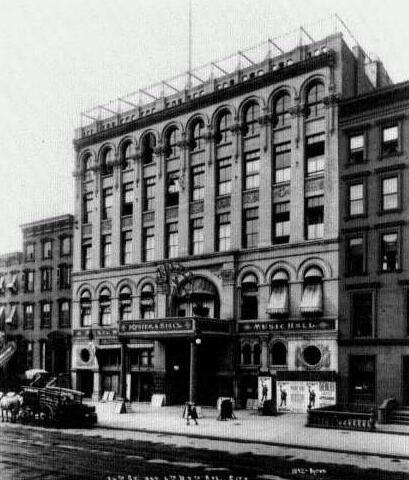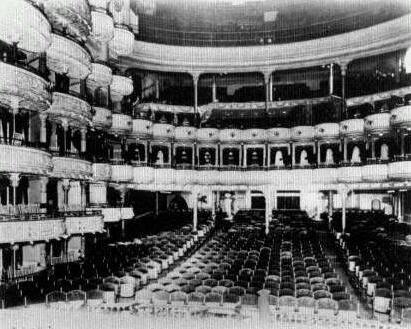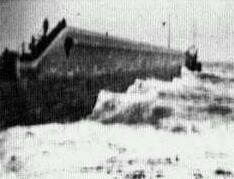The Vitaseope's Premiere
Raff & Gammon moved quickly forward with their first public exhibitions of Edison's vitascope. They sent Charles Webster to Europe with one screen machine on April 22d.[16] Only when he arrived in London and saw the Lumière cinématographe did it become fully evident that the vitascope would face insurmountable difficulties in foreign markets. To replace their absent employee, Raff & Gammon hired James White, Webster's former associate, in early April for $75 a month.[17] Arrangements were soon finalized for the Koster & Bial's premiere on April 23d. The fee was set at $800 per week, providing Raff & Gammon with a bountiful income during the ensuing four-month run.[18] Thomas Armat acted as moving picture operator (i.e., projectionist) for the first week, after which he was succeeded by his brother. White assumed overall responsibility for the Koster & Bial's showings.[19] Edwin Porter, while still in the navy, may have helped in his off hours to install the electrical system that ran the machine.[20] The opening night response was ecstatic. "WONDERFUL IS THE VI-TASCOPE," proclaimed the New York Herald .[21]The New York Times enthused:
The new thing at Koster and Bial's last night was Edison's vitascope, exhibited for the first time. The ingenious inventor's latest toy is a projection of his kinetoscope
Koster & Bial's Music Hall at the time of the vitascope premiere.
figures in stereopticon fashion, upon a white screen in a darkened hall. In the centre of the balcony of the big music hall is a curious object, which looks from below like the double turret of a big monitor. In the front of each half of it are two oblong holes. The turret is neatly covered with the blue velvet brocade which is the favorite decorative material of this house.[22]
The New York Daily News added:
On the stage, when it was ready to show the invention a big drop curtain was lowered. It had a huge picture frame painted in the center with its enclosed space
Interior of Koster & Bial's. The vitascopes are hidden within
their turret-shaped housing in the second mezzanine.
white. The band struck up a lively air and from overhead could be heard a whirring noise that lasted for a few moments; then there flashed upon the screen the life-size figures of two dancing girls, who tripped and pirouetted and whirled an umbrella before them. The representation was realistic to a degree. The most trifling movements could be followed as accurately as if the dancers had been stepping before the audience in proper person. Even the waving undulations of their hair were plainly distinguishable. The gay coloring of the costumes was also effectively shown.[23]
Six films were shown, but only five were made by the Edison Company. The first to be projected was a tinted print of Umbrella Dance , with the Leigh sisters. Subsequent views included Walton and Slavin (a burlesque boxing bout from 1492), Finale of 1st Act of Hoyt's "Milk White Flag " (not listed on the programme), and The Monroe Doctrine . Made in preparation for the vitascope debut, The Monroe Doctrine offered a new type of subject matter, a comic allegory that was overtly political. Referring to a recent incident in South America, this political cartoon on film showed John Bull and Venezuela fighting. "Uncle Sam appears, separates the combatants and knocks John Bull down."[24] The patriotic audience was delighted and "cheers rang through the house, while somebody cried, 'Hurrah for Edison.' "[25] The final film was of a skirt or ser-
Rough Sea at Dover (1895), taken by R. W.
Paul in England. The hit of opening night.
pentine dance. Although the dancer was blonde, none of the reviews indicate she was Annabelle.
Opening night critics were most impressed by the second film to be shown, Rough Sea at Dover , of a wave crashing on a shore. This subject, the only one not shot in the Black Maria and the only "actuality," had been sent to Edison by his English competitor Robert Paul:
The whirr of the machine brought to view a heaving mass of foam-crested water. Far out in the dim perspective one could see a diminutive roller start. It came down the stage, apparently, increasing in volume, and throwing up little jets of snow-white foam, rolling faster and faster, and hugging the old sea wall, until it burst and flung its shredded masses far into the air. The thing was altogether so realistic and the reproduction so absolutely accurate, that it fairly astounded the beholder. It was the closest copy of nature any work of man has ever yet achieved.[26]
Paul's film pointed out the possibilities of aggressively assaulting or confronting spectators with the image rather than simply using the camera for passive display. Patrons in the front rows were disconcerted and inclined to leave their seats as the wave crashed on the beach and seemed about to flood the theater.
Like Edison's peep-hole kinetoscope, the vitascope used a twenty-second loop of film spliced end to end and threaded on a bank of rollers. Raft & Gammon suggested that "a subject can be shown for ten or fifteen minutes if desired, although four or five minutes is better."[27] When, as in most cases, one projector was used, a two-minute wait occurred between films. At Koster & Bial's in New York, however, projectors worked in tandem and there was no wait. Even under these conditions, films still had to be projected for at least two minutes while a new film was threaded on to the other projector. Thus, each subject was necessarily shown at least six times. As one journalist remarked, "The scene is repeated several times, then the click click stops, and the screen is blank. A moment's interval, then a pretty blonde serpentine dancer appeared."[28] Although two projectors eliminated waiting periods between films, they did not
reduce the number of times a film was projected at one showing, nor were they customarily used to juxtapose related images. There was little room or concern with editorial techniques in these first exhibitions. Films were usually shown separately and treated as discrete images. In Cleveland, for example, waits were eliminated by alternating films with musical selections by the Chicago Marine Band.[29] Later, some exhibitors filled these interludes by showing "dissolving views" (i.e., lantern slides).
The absence of complex cinematic meanings has sometimes been seen as proof of the screen's primitive qualities, but this simplicity effectively emphasized the novel contribution of moving pictures to screen practice. Audiences, while accustomed to projected photographs that were static and to projected nonphotographic images that could move, were tremendously impressed by animated photographs projected on the screen. "Life-like" motion in conjunction with "life-like photography" and a "life-size" image provided an unprecedented level of verisimilitude. And yet cinema's novelty period involved much more than the exhibition of lifelike images. The rapid diversification of subject matter and the increasingly frequent sequencing of images constantly renewed cinema's ability to intrigue and entertain even regular vaudeville customers during the 1896-97 theatrical season. The first year of projected motion pictures, often called cinema's "novelty period," was one of multiple, successive innovations and not, as some have suggested, an undifferentiated period that simply relied on the new sensation of projected motion pictures.


